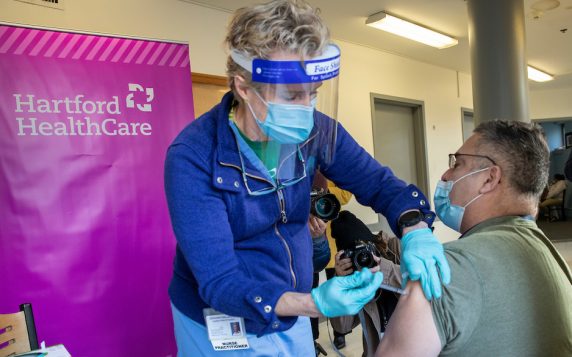Too many people probably believe the pandemic is ending, but the National COVID-19 Preparedness Plan released this week by the White House at least signals the end of the pandemic’s crisis phase.
“I don’t agree that we are post-COVID,” says Dr. Ulysses Wu, Hartford HealthCare’s System Director of Infection Disease and Chief Epidemiologist. “We are never really post-COVID – we are just post-surge. COVID is still here.”
Living with COVID, according the White House plan that will require funding from Congress, includes these four primary goals:
1. Protection Against, and Treatments for, COVID-19
Highlights: A “test to treat” policy allows pharmacists to provide prescriptions immediately for a treatment such as Paxlovid, an antiviral developed by Pfizer, to anyone who tests positive. . . . Masks, vaccines, tests and treatments remain the primary preventive tools. . . . The administration will quickly distribute nationally a vaccine for children under 5 years old as soon as it’s available.
2. Preparing for the Next Variants
Highlights: A new COVID-19 variant playbook assess a variant’s transmissibility and severity, and its potential impact on vaccines and treatment. . . . The mRNA technology used in the Pfizer-BioNTech and Moderna vaccines allow the production, authorization and delivery of new vaccines and treatments within 100 days. . . . The plan includes provisions for new stockpiles of high-quality masks (including masks for kids), at-home tests and antiviral pills.
3. Preventing School and Business Shutdowns
Highlights: An Environmental Protection Agency checklist for clean air in buildings promises better indoor air quality, reducing the likelihood of the virus spreading through the workplace. . . . Reinstating tax credits so small and midsize businesses can offer paid sick and family leave for those sick with COVD-19.
4. Vaccinate the World
Highlights: The United States is donating 1.2 billion doses to the world’s case, with 480 million doses to 112 countries already shipped. That effort will continue. . . . Support public education. . . . Provide vaccinators in the field and set up vaccination sites.
Elsewhere in the 96-page plan, the administration said it would fight misinformation and disinformation. The Department of Health and Human Services would rely on community “trusted messengers” and 17,000 volunteers to fight vaccine hesitancy.
HHS, the Defense Department and other agencies also will coordinate research on long COVID, symptoms that last weeks or months after being infected.
Why Is March 18 an Important Date?
The federal mask mandate for planes, trains, buses and airports and other transit stations expires March 18. The federal government has not announced plans to extend it.



